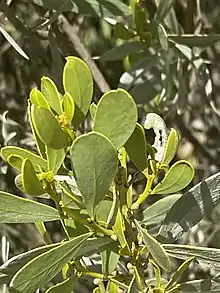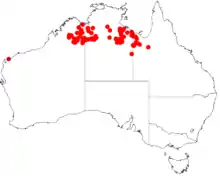| Acacia argyraea | |
|---|---|
 | |
| Scientific classification | |
| Kingdom: | Plantae |
| Clade: | Tracheophytes |
| Clade: | Angiosperms |
| Clade: | Eudicots |
| Clade: | Rosids |
| Order: | Fabales |
| Family: | Fabaceae |
| Subfamily: | Caesalpinioideae |
| Clade: | Mimosoid clade |
| Genus: | Acacia |
| Species: | A. argyraea |
| Binomial name | |
| Acacia argyraea | |
 | |
| Occurrence data from AVH | |
Acacia argyraea is a shrub belonging to the genus Acacia and the subgenus Juliflorae that is endemic to tropical parts of northern Australia.
Description
The silvery-grey shrub typically grows to a height of 0.8 to 3 metres (3 to 10 ft).[3] It has smooth, grey to brown coloured bark with two or three angled branchlets covered in dense silky hairs. Like most species of Acacia it has phyllodes rather than true leaves. The flat and evergreen phyllodes have a narrowly elliptic to elliptic shape with a length of 4 to 8 cm (1.6 to 3.1 in) and a width of 15 to 35 mm (0.59 to 1.38 in) and have three to six prominent longitudinal nerves present of the face if the phyllode.[4] It blooms from April to July producing yellow flowers.[3]
Distribution
It is native to an area of the Kimberley region of Western Australia,[3] to the Northern Territory and north western Queensland[5] north of around 20° in latitude, but is considered to be quite rare in Queensland. It is often in found around areas of shale, but also will grow in lateritic and sandy soils.[4]
See also
References
- ↑ "Acacia argyrea". Australian Plant Name Index, IBIS database. Centre for Plant Biodiversity Research, Australian Government.
- ↑ Tindale, M.D. in Anderson, R.H. (ed.) (1970) Notes on Australian taxa of Acacia No. 2. Contributions from the New South Wales National Herbarium 4(3): 141.
- 1 2 3 "Acacia argyraea". FloraBase. Western Australian Government Department of Biodiversity, Conservation and Attractions.
- 1 2 "Acacia argyraea". Wattle- Acacias of Australia. Lucid Central. Retrieved 10 March 2020.
- ↑ Govaerts, R. et al. (2019) Plants of the world online: Acacia argyrea. Board of Trustees of the Royal Botanic Gardens, Kew. Retrieved 6 March 2019.